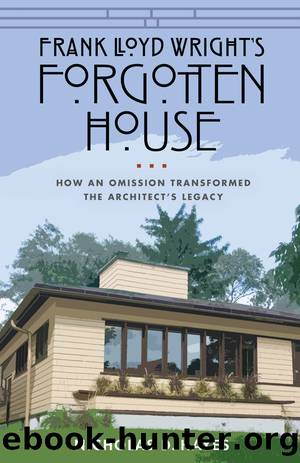Frank Lloyd Wright's Forgotten House by Nicholas D. Hayes

Author:Nicholas D. Hayes [Hayes, Nicholas D.]
Language: eng
Format: epub
ISBN: 9780299331887
Publisher: University of Wisconsin Press
Front elevation showing light openings, or âgrills,â on the sleeping porch opening on a Model A203 (drawn in reverse of the home built at 2106 East Newton Avenue). American System-Built (Ready-Cut) houses for The Richards Company, Front/Rear Elevation, Frank Lloyd Wright Foundation Archives, 1506.295.
Side entrance elevation of the Model A203 (drawn in reverse of the home built at 2106 East Newton Avenue). American System-Built (Ready-Cut) houses for The Richards Company, Side/Front Elevations, Frank Lloyd Wright Foundation Archives, 1506.298.
That said, we can imagine a warm breeze blowing through it, with grids of sunlight and shadow crisscrossing the floor creating the feeling of a forest of tall pines on a summer day. It was another planned experience but one that has not been experienced by anyone, ever; an organic luxury drawn by Wright but missed by all because it was omitted.
The fact that the programâs signature decorative feature was not included in this home forced us to wonder if the decision to leave out the light openings was made by the builder Herman Krause, the investor Elizabeth Murphy, or first owner-occupants Alfred and Gladys Kibbie. Given that the Kibbies could not have arrived on the scene until after the pebble dash was struck, we can eliminate them from our list of suspects, leaving the other two and leading us to surmise that either Krause had run out of money and lumber and didnât think that the light openings and the complex grid work to make them were necessary, or Murphy made a speculatorâs decision to save cost and time on a tardy project and struck the luxury from the work order. In the latter line of thinking, it is easy to imagine that Murphy made the decision to enclose the sleeping porch so as to offer a larger home for sale, meaning that the grills were eliminated and the fragile pebble dash protected, though records of her decision donât exist.
The mishandling of light openings, among the myriad oddities in the building of the home, is the most visible change to the original specification, though it is not the most flagrant. The most flagrant change deserves a chapter of its own, to come.
A visitor once asked if we plan to return the sleeping porch to Wrightâs intended duty by removing the glass windows and adding, for the first time, these light openings. Unfortunately, we cannot. On the one hand, reopening the windows might bring the outside in again, but on the other hand, the historic pebble dash would then resume rapid deterioration with temperature change and be lost to the ages. So instead, this home must remain what it is: a Frank Lloyd Wright design that did not and will not boast Wrightâs most flamboyant branding, one that survived tumultuous times, kept its secrets well, and now is finding its own special place in history.
Download
This site does not store any files on its server. We only index and link to content provided by other sites. Please contact the content providers to delete copyright contents if any and email us, we'll remove relevant links or contents immediately.
Kathy Andrews Collection by Kathy Andrews(11730)
The remains of the day by Kazuo Ishiguro(8825)
Paper Towns by Green John(5091)
Spare by Prince Harry The Duke of Sussex(5073)
Industrial Automation from Scratch: A hands-on guide to using sensors, actuators, PLCs, HMIs, and SCADA to automate industrial processes by Olushola Akande(4985)
The Body: A Guide for Occupants by Bill Bryson(4974)
Machine Learning at Scale with H2O by Gregory Keys | David Whiting(4184)
Be in a Treehouse by Pete Nelson(3950)
Never by Ken Follett(3794)
Harry Potter and the Goblet Of Fire by J.K. Rowling(3775)
Goodbye Paradise(3728)
Into Thin Air by Jon Krakauer(3313)
The Remains of the Day by Kazuo Ishiguro(3294)
The Cellar by Natasha Preston(3262)
The Genius of Japanese Carpentry by Azby Brown(3226)
Fairy Tale by Stephen King(3220)
120 Days of Sodom by Marquis de Sade(3182)
The Man Who Died Twice by Richard Osman(2997)
Drawing Shortcuts: Developing Quick Drawing Skills Using Today's Technology by Leggitt Jim(2996)
